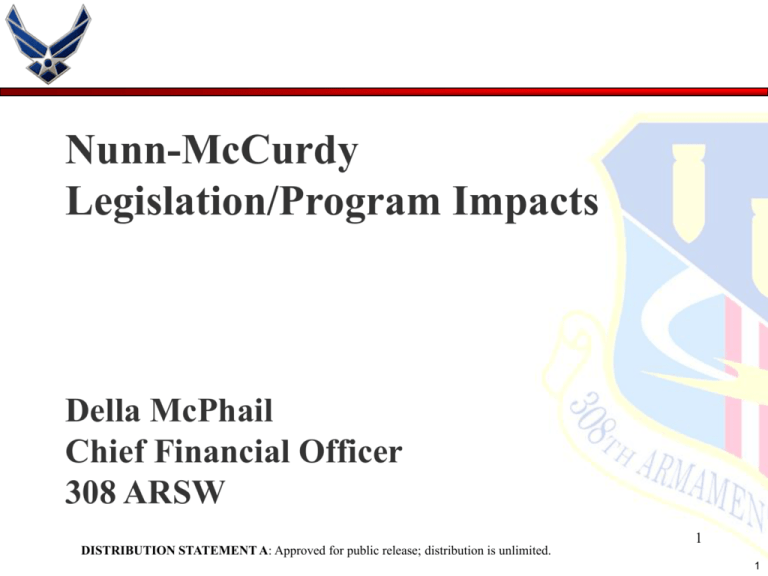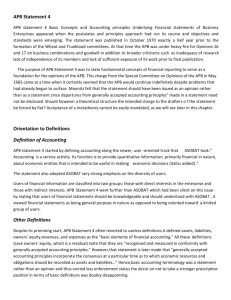ACQUISITION REPORTING - NDIA : Gulf Coast Chapter
advertisement

Nunn-McCurdy Legislation/Program Impacts Della McPhail Chief Financial Officer 308 ARSW DISTRIBUTION STATEMENT A: Approved for public release; distribution is unlimited. 1 1 Outline • • • • • • Unit Cost Reporting (UCR) Acquisition Program Baseline (APB) Unit Cost Breaches Certification Process Anatomy of a Unit Cost Breach Reduce Risk of a Unit Cost Breach 2 2 Nunn-McCurdy Unit Cost Reporting: Background/Purpose • To provide Congressional unit cost reporting for Major Defense Acquisition Programs (MDAPs) • Drafted by Senator Nunn in 1982 (Representative McCurdy co-sponsored) • Title 10, United States Code, Section 2433 (Unit Cost Reports) and Section 2435 (Baseline Description) • Largely unchanged until FY06 National Defense Authorization Act (NDAA) in January 2006 3 3 Nunn-McCurdy Unit Cost Reporting (UCR): Unit Cost Measurements • Two UCR criteria: -- Program Acquisition Unit Cost (PAUC) -- Average Procurement Unit Cost (APUC) • Definitions (in base-year $) : -- PAUC = [Total Development $ + Procurement $ + Construction $] / Total program quantity -- APUC = Total Procurement $ / Procurement quantity • Other Unit Cost Measure: Average Unit Production Price (AUPP) Not a Nunn-McCurdy Measure! 4 4 Nunn-McCurdy Unit Cost Reporting: Unit Cost Tracking • Compare Current Estimate to Current Baseline Estimate and to Original Baseline Estimate -- Current Estimate – Latest estimate of approved program -- Current Baseline Estimate – currently approved Acquisition Program Baseline (APB) -- Original Baseline Estimate – APB approved at Milestone B or program initiation, whichever occurs later 5 5 Acquisition Program Baseline (APB): Purpose • Contract between the Program Manager (PM) and the Milestone Decision Authority (MDA) – Documents program performance, schedule, and cost goals (objectives and thresholds) • Becomes reference point for measuring program status • Establishes the PM’s trade space: – How is the system supposed to perform? – When are critical events to occur? – How much will it cost? • Identifies deviation limits (thresholds) beyond which the PM may not exceed without authorization from the MDA 6 6 Acquisition Program Baseline (APB): Original Baseline • First APB - prepared just before a program enters SDD (Milestone B) or program initiation, whichever occurs later • For programs designated as MDAPs after Milestone B or program initiation, the Original APB is the first APB approved as an MDAP • Serves as the current baseline description until a revised APB is prepared at a major milestone, full rate production, or deviation (breach) • The cost estimate parameter may be revised under 10 U.S.C. 2435 only if a breach occurs that exceeds a critical cost growth threshold for the program under 10 U.S.C. 2433 7 7 Acquisition Program Baseline (APB): Current Baseline • Shall be revised at major milestone decisions & full rate production • Revisions to cost or other APB parameters are not automatically authorized if there is a change to cost, schedule, or performance • May be revised only: – As a result of a major program restructure that is fully funded and approved by the MDA – As a result of a program deviation (breach), if the MDA determines that the breach is primarily beyond control of the PM • Multiple revisions may not be authorized, and in no event will a revision be authorized if proposed merely to avoid a reportable breach • MDA determines whether to revise the APB 8 8 Acquisition Program Baseline (APB): Default Thresholds • Performance: No default (However, if no threshold provided, threshold = objective values) • Schedule: 6 months after the objective date • Cost: 10% above objective values (BY$) Note: Non-default thresholds can be used if justified and approved by the MDA 9 9 Acquisition Program Baseline (APB): Deviations (Breach) • PM shall immediately notify the MDA of a deviation (beyond threshold) in any cost, schedule, or performance parameter (via Program Deviation Report (PDR) • Within 30 days of occurrence of the deviation, the PM shall inform the MDA of the reason for the deviation and planned actions • Within 90 days of occurrence of the deviation – A proposed revised APB shall be submitted for approval; or – An OIPT or equivalent Component-level review shall be held to review the program • The MDA shall decide based on above criteria whether it is appropriate to approve a revision to an APB 10 10 Unit Cost Breaches New requirements from FY06 NDAA New Definitions “Significant” Current Baseline Estimate Original Baseline Estimate New Nunn-McCurdy thresholds against Original Baseline Estimate +15% +30% Notification and SAR “Critical” + 25% +50% Notification, SAR, and Certification PAUC or APUC (measured in base-year $) Perception: Rebaselining Allowed Cost Growth to Go Unreported 11 11 Acquisition Program Baselines: Examples 12 12 Reporting Unit Cost Breaches • Program has a Breach to PAUC and/or APUC • Breach May be “Significant” or “Critical” • What Happens Now? 13 13 Nunn-McCurdy Unit Cost Reporting: Reporting Requirements • For “Significant” breaches: -- Service Secretary must notify Congress within 45 days after the report (normally program deviation report) upon which the determination is based -- Submit a Selected Acquisition Report (SAR) with the required additional unit cost breach information 14 14 Nunn-McCurdy Unit Cost Reporting: Reporting Requirements • For “Critical” breaches -- In addition to notification and SAR, the USD(AT&L) must certify to Congress within 60 days of SAR that: 1. The program is essential to the national security 2. There is no alternative which will provide equal or greater capability at less cost 3. The new estimates of the PAUC & APUC are reasonable 4. The management structure is adequate to control PAUC & APUC (Note: No certification required for a terminated program) 15 15 Nunn-McCurdy Unit Cost Reporting: Certification Process • USD(AT&L) establishes an IPT for each of the 4 certification criteria • Periodic meetings held: -- USD(AT&L) -- Principals IPTs (i.e., Executive Review Team) -- Joint Requirements Oversight Council (JROC) • Site visits to contractor and PM locations • Process outputs: -- Certification package to Congress (Letters with supporting explanation) -- Acquisition Decision Memorandum (ADM) 16 16 Nunn-McCurdy Unit Cost Reporting: Penalties • Suspension of Obligations -- If either SAR or certification are not submitted on time, obligational authority suspended on all major contracts -- Suspension shall cease to apply after 30 days of continuous session of Congress (starting from the date of receipt of SAR/certification) 17 17 Nunn-McCurdy Unit Cost Reporting: Anatomy of a Breach • Change in requirements since baseline • Development or production stretch outs • Premature entry into production • Technical or performance/reliability issues • Lack of quantification of risk (Cost) • Optimism in schedule and testing • Decrease in Production Quantities 18 18 Structuring to Help Avoid Nunn-McCurdy • Establish separate programs for new capabilities – Calls for new APBs • Better define requirements – Balance, prioritize capabilities based on funding, schedule and technology • Finalize requirements documentation early – ICD, CDD • Quantify tech risks – assign dollars to those risks • Fund contracts to realistic cost estimate • Use the right metrics 19 19 Summary • FY06 NDAA included new definitions for Nunn-McCurdy Breaches • New definitions driving more occurrences of Nunn-McCurdy Breaches • Means and ability exist to mitigate risk of Unit Cost Breaches 20 20





